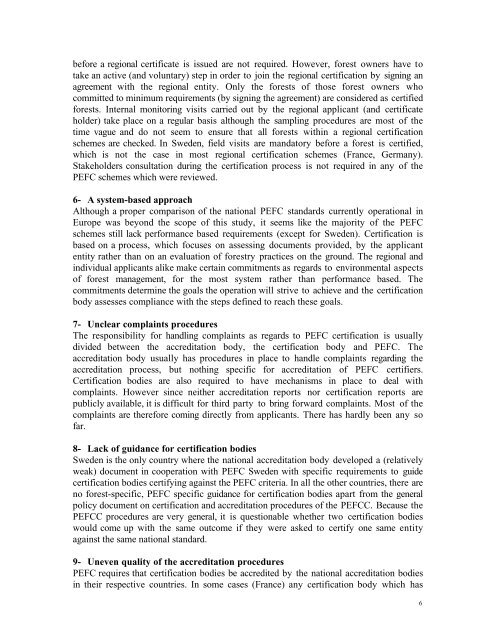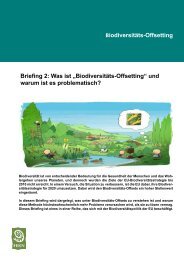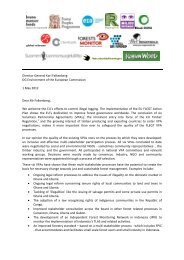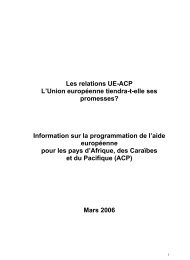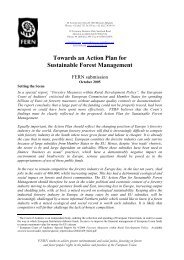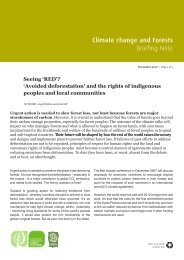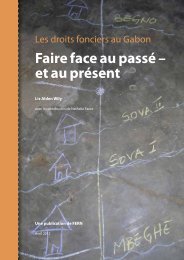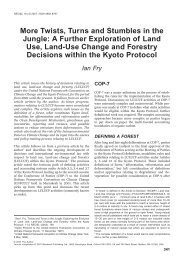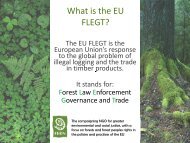Footprints in the forest - Fern
Footprints in the forest - Fern
Footprints in the forest - Fern
You also want an ePaper? Increase the reach of your titles
YUMPU automatically turns print PDFs into web optimized ePapers that Google loves.
efore a regional certificate is issued are not required. However, <strong>forest</strong> owners have to<br />
take an active (and voluntary) step <strong>in</strong> order to jo<strong>in</strong> <strong>the</strong> regional certification by sign<strong>in</strong>g an<br />
agreement with <strong>the</strong> regional entity. Only <strong>the</strong> <strong>forest</strong>s of those <strong>forest</strong> owners who<br />
committed to m<strong>in</strong>imum requirements (by sign<strong>in</strong>g <strong>the</strong> agreement) are considered as certified<br />
<strong>forest</strong>s. Internal monitor<strong>in</strong>g visits carried out by <strong>the</strong> regional applicant (and certificate<br />
holder) take place on a regular basis although <strong>the</strong> sampl<strong>in</strong>g procedures are most of <strong>the</strong><br />
time vague and do not seem to ensure that all <strong>forest</strong>s with<strong>in</strong> a regional certification<br />
schemes are checked. In Sweden, field visits are mandatory before a <strong>forest</strong> is certified,<br />
which is not <strong>the</strong> case <strong>in</strong> most regional certification schemes (France, Germany).<br />
Stakeholders consultation dur<strong>in</strong>g <strong>the</strong> certification process is not required <strong>in</strong> any of <strong>the</strong><br />
PEFC schemes which were reviewed.<br />
6- A system-based approach<br />
Although a proper comparison of <strong>the</strong> national PEFC standards currently operational <strong>in</strong><br />
Europe was beyond <strong>the</strong> scope of this study, it seems like <strong>the</strong> majority of <strong>the</strong> PEFC<br />
schemes still lack performance based requirements (except for Sweden). Certification is<br />
based on a process, which focuses on assess<strong>in</strong>g documents provided, by <strong>the</strong> applicant<br />
entity ra<strong>the</strong>r than on an evaluation of <strong>forest</strong>ry practices on <strong>the</strong> ground. The regional and<br />
<strong>in</strong>dividual applicants alike make certa<strong>in</strong> commitments as regards to environmental aspects<br />
of <strong>forest</strong> management, for <strong>the</strong> most system ra<strong>the</strong>r than performance based. The<br />
commitments determ<strong>in</strong>e <strong>the</strong> goals <strong>the</strong> operation will strive to achieve and <strong>the</strong> certification<br />
body assesses compliance with <strong>the</strong> steps def<strong>in</strong>ed to reach <strong>the</strong>se goals.<br />
7- Unclear compla<strong>in</strong>ts procedures<br />
The responsibility for handl<strong>in</strong>g compla<strong>in</strong>ts as regards to PEFC certification is usually<br />
divided between <strong>the</strong> accreditation body, <strong>the</strong> certification body and PEFC. The<br />
accreditation body usually has procedures <strong>in</strong> place to handle compla<strong>in</strong>ts regard<strong>in</strong>g <strong>the</strong><br />
accreditation process, but noth<strong>in</strong>g specific for accreditation of PEFC certifiers.<br />
Certification bodies are also required to have mechanisms <strong>in</strong> place to deal with<br />
compla<strong>in</strong>ts. However s<strong>in</strong>ce nei<strong>the</strong>r accreditation reports nor certification reports are<br />
publicly available, it is difficult for third party to br<strong>in</strong>g forward compla<strong>in</strong>ts. Most of <strong>the</strong><br />
compla<strong>in</strong>ts are <strong>the</strong>refore com<strong>in</strong>g directly from applicants. There has hardly been any so<br />
far.<br />
8- Lack of guidance for certification bodies<br />
Sweden is <strong>the</strong> only country where <strong>the</strong> national accreditation body developed a (relatively<br />
weak) document <strong>in</strong> cooperation with PEFC Sweden with specific requirements to guide<br />
certification bodies certify<strong>in</strong>g aga<strong>in</strong>st <strong>the</strong> PEFC criteria. In all <strong>the</strong> o<strong>the</strong>r countries, <strong>the</strong>re are<br />
no <strong>forest</strong>-specific, PEFC specific guidance for certification bodies apart from <strong>the</strong> general<br />
policy document on certification and accreditation procedures of <strong>the</strong> PEFCC. Because <strong>the</strong><br />
PEFCC procedures are very general, it is questionable whe<strong>the</strong>r two certification bodies<br />
would come up with <strong>the</strong> same outcome if <strong>the</strong>y were asked to certify one same entity<br />
aga<strong>in</strong>st <strong>the</strong> same national standard.<br />
9- Uneven quality of <strong>the</strong> accreditation procedures<br />
PEFC requires that certification bodies be accredited by <strong>the</strong> national accreditation bodies<br />
<strong>in</strong> <strong>the</strong>ir respective countries. In some cases (France) any certification body which has<br />
6


